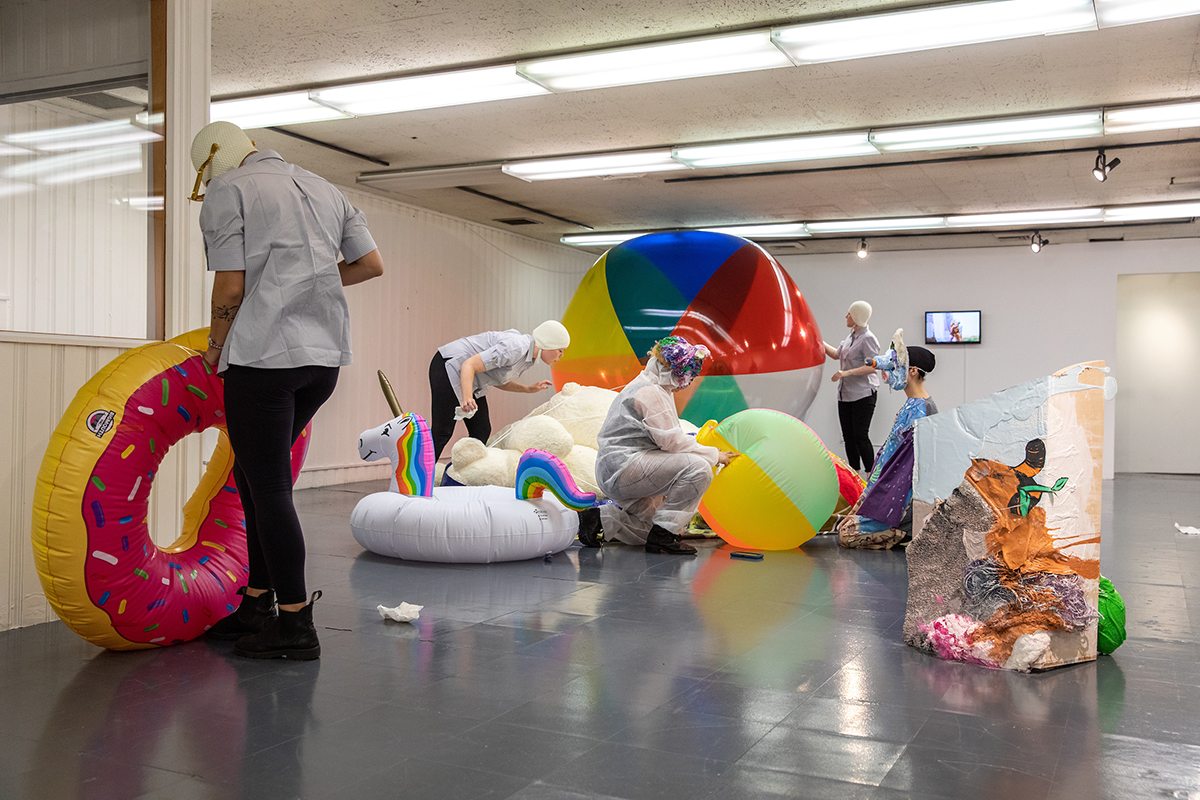Katya Grokhovsky speaks on her experience with materialism after immigrating to the U.S.
With huge beach balls, oversized stuffed animals, and obscure sculptures, the nuanced message of overconsumption can’t be missed in Katya Grokhovsky’s new exhibit, FANTASYLAND. The mixed media presentation is opening on March 20 at Smack Mellon, a nonprofit arts organization, in the DUMBO neighborhood of Brooklyn.
The exhibit includes bright colors and single-purpose toys that draw viewers in. But, idealistic consumerism fades as chaos in the form of excess grows, and the façade for joy becomes more clear. Once the momentary gaiety wears off, the consumer is subliminally imprisoned by their attachment to mere items that are destined to deteriorate into meaningless trash, argues Grokhovsky.
Having been brought up in Ukraine, the immigrant artist was shocked at the levels of mindless materialism that are ever present in the West. Grokhovsky spoke with Mission about her current exhibit and expanded on what it means to live a better life.
Madeline Brik: What inspired you to become an artist?
Katya Grokhovsky: I was basically born an artist. Ever since I was very little, I was quite creative and always drawing, painting, making things, daydreaming, writing, and putting on some strange live performances for friends and family. I went to an art school for children in Ukraine and then studied art and design as an adult in Australia, U.K. and the U.S.A. The decision I had to eventually make was to build my life in full support and dedication to my art and learn how to maintain it as a professional career, which is no easy feat, especially as a woman. The sustainability of an art practice is very difficult and full of obstacles. For inspiration to keep going I often turn to fellow artists who are my contemporaries or came before me.
MB: How is your art a form of restoration and reclamation for immigrants? When did you leave Ukraine and what has your experience been like in the U.S.?
KG: I am a double immigrant. I was born in Ukraine and migrated to Australia when I was 15 years old with my family. I came to the U.S. in 2009 as a candidate for the Masters of Fine Arts program at The School of the Art Institute of Chicago. Post-graduation, I migrated here on my own. My experience in the U.S. has been a journey of establishing my active practice as an artist, curator, and educator: a rollercoaster of immigration and art adventures. It has been both extremely frustrating at times and quite exhilarating. It is now my home.
My artistic practice reflects and explores migration and displacement, which are threads running through most of my work. A curatorial platform called The Immigrant Artist Biennial, which I established in 2019 and premiered in 2020 in NYC, was especially designed to support underrecognized immigrant artists living and working in the U.S., who might not have an encouraging platform or a community to present their works.

MB: What is your relationship to consumerism? How did you perceive American consumerist culture when you first moved to the U.S., and how has your relationship with it evolved over time?
KG: I was born in the former USSR and do not remember encountering a “real” shopping mall until I was a teenager in Australia. Consumerism was never part of my childhood and I didn’t understand the concept of it, until I moved to the West. I grew up longing for “useless” beautiful things I saw in magazines and on TV, as a symbol of luxury and leisure, and perhaps it is ironic now, I am an artist who essentially makes these. U.S. materialism and greed, as well as wasteful attitudes and thirst for the new, still shocks me. I have never seen so many discarded consumer goods in good condition, replaced before their time, and I am fascinated by this impulse and desire. My work deals with these issues consistently through a revolving door of recycling, acquiring, reassembling, and reinventing.
MB: Why do you think consumerism is often viewed as a symbol for freedom rather than imprisonment?
KG: I guess it offers a mirage of opportunity, a certain future of the renewable, the fleeting satisfaction of ownership, until it becomes old again and the feeling needs to be replenished. Consumerism, although presented as a beacon of wish and want, is an addiction and a danger to the planet. Objects both delight and imprison us. At some point in my artistic process, I walk a line of never-ending overproduction, and stop and pivot to reinvention and recycling what I already own rather than always starting from scratch. The ideas are new, but I prefer for the materials at the core of my sculptural works to be discarded or pre-owned and passed down.
MB: If not material consumerism, what is your perspective of a better life? How does your background inform your answer?
KG: My idea of a better life is a life lived with freedom of choice, bravery, gusto, risk, and adventure, free of oppression, injustice, and societal pressure to conform to certain norms and laid out plans. We are never fully free from consumerism, but it shouldn’t rule human life. Coming from a background of scarcity contradicts my answer, as I should be desiring of “things,” and always having plenty of everything, but I’d rather own less and travel the world, freely making my art dreams come true, spending time with extraordinary people, acquiring experiences, knowledge, ideas, and making lasting memories, than buy another item of clothing.
Image credit: Katya Grokhovsky, Theater of the Mundane 2018. Photographer: Walter Wlodarczyk




